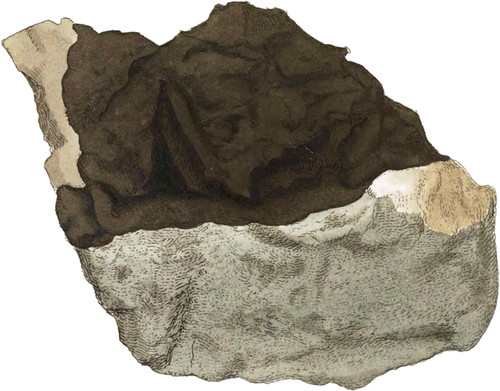 Enlarge
Enlarge
British Mineralogy
Elastic Bitumen, or Fossil Caout-chou
- Class 1. Combustibles.
- Order 1. Homogeneous.
- Gen. 1. Hydrogen*.
- Spec. 1. Bitumen.
- Gen. Char. Inflammable, easily converted into gas by calor. Forms water by combustion with oxygen gas.
- Spec. Char. Nearly pure, fœtid, not easily volatile.
- Syn.
- Elastic Bitumen. Hatchett in Linn Trans. v. 4. 146.
- Bitume élastique. Haüy, v. 3. 313.
- Mineral Cahoutchou. Kirwan, v. 2. 48.
- Elastisches erdpech. Karsten, 42.
- Cahoutchou fossile. Laméthérie, v. 2. 540.
The Elastic Bitumens were first noticed at Castleton, in Derbyshire, about the year 1786. Perhaps their general resemblance to the Caout-chou, or Indian rubber, discovered about half a century ago, might in a great measure be the cause of their being noticed; for we are often struck with the comparative resemblance of a thing which otherwise might have passed unnoticed. It is however a curious circumstance that they have not been discovered elsewhere, although Petroleum, Naphta, and analogous substances, as Matha, Mineral Tar, Pitch, and Aslphaltum, which are nearly related to the above, are found in many parts of the world, as well as Castleton, where this substance is found. These always differ from the vegetable substances of the same nature (viz.) common Tar and Pitch, by their peculiar odour, which somewhat resembles oil of brick, used by Lapidaries, and which I understand is a kind of burnt oil. It is very different from the well known scent of Pitch and Tar. Vegetable Caout-chou differs from both. So, we may say that the under-ground change seems to be the cause of the odour. We cannot at present account for the elasticity, otherwise than in the words of the ingenious Mr. Hatchett in the Linnean Transactions: “From what I have already related, I suspect that the elastic property is occasioned by the interposition of very minute portions of air, or some other elastic fluid between the parts of the Bitumen, and that this takes place by means of some unknown cause at the time of formation; for, when these Bitumens are melted, the elastic fluid is liberated, and the mass loses that fine spongy texture which I suspect to have been the cause of the elastic property.”
It is somewhat curious that it is found as it were oozing out of, or attached to, the rocks. The present specimen is attached to common Limestone rock, mostly Stinkstein: see p. 81 Brit. Min. It is nearly the softest of the elastic sort: some parts of it are almost an oleaginous state, and stick to the fingers. It is nearly the colour of common Caout-chou, but will not stretch out like it, although it springs to its form after compression; and hence it differs a little from Caout-chou, as the indenture of the impressio is not so easily made permanent. It is by no means so tough as common Indian rubber.
- * Unknown in its pure state, unless as the softest and purest Bitumen.

